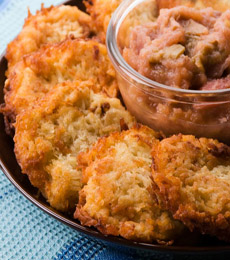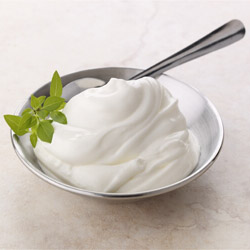 Potato latkes and applesauce. Photo courtesy of Zabar's. Potato latkes and applesauce. Photo courtesy of Zabar's.
December 2009
|
 |
Potato Latke Recipe
Quick & Easy Potato Latkes
Latke is the yiddish word for pancake; the word leviva, the Hebrew name for latke, is found in the Book of Samuel. Potato latkes are a Chanukah tradition, but they are enjoyed year-round. Latkes are traditionally eaten by Ashkenazi Jews during the Chanukah. The oil in which the latkes are fried is another tribute to the miracle of Chanukah. In ancient Judea, the Syrian king Antiochus ordered the Jewish people to abandon their religion and worship the Greek gods. Judah, leader of the band that called themselves the Maccabees (Hebrew for hammer), drove the Syrians from Israel and reclaimed the Second Temple in Jerusalem, removing the Greek statues. They finished their work on the 25th day of the month of Kislev, and wanted to light the eternal light (N’er Tamid), present in every Jewish house of worship, to rededicate the temple. Once lit, the light should never be extinguished. But there was only a tiny jug of lamp oil—enough for a single day. A miracle occurred: the light burned for eight days. This is the origin of Chanukah, the Festival of Lights, which is celebrated for eight days. The word Chanukah means “rededication.”
Grandma Bertha’s Latkes
This recipe for quick, light and crisp latkes is from Andrea Watman, Creative Director at New York City’s legendary Zabar’s. It makes approximately 30 latkes.
This latke recipe is a simple one. This adaptation uses a food processor and potatoes that are not peeled; it should only take minutes to prepare. The recipe is Andrea’s grandmother’s. The latke recipes of Grandma Bertha’s time required labor-intensive peeling of the potatoes, then grating them on a four-sided metal grater—which invariably ended up scraping one’s knuckles as well. The hand grating took so long that the potatoes would start to discolor. Only the enjoyment of the delicious finished latkes made one forget the travail of making them.
Andrea improved upon the recipe by tossing the potatoes, peel and oil, into the food processor. She also uses a coffee scoop to measure the batter. She finds that it makes latkes that are “just the right size.” If you don’t have a coffee scoop, you can use a 1/4 cup measure, which makes larger latkes.
Some people like a sweet garnish—applesauce, for example. Others prefer sour cream. For an elegant touch, top latkes with smoked salmon, crème fraîche and snipped chives.
Ingredients
- 4 Idaho potatoes, washed but not peeled
- 1 large yellow onion
- 3 large eggs
- 1-2 cups regular flour
- 1 tablespoon coarse salt
- ½ tablespoon fresh-ground pepper
- Oil for frying (Andrea uses half olive oil, half corn oil)
- Applesauce and/or sour cream for
garnish
- Editor’s Note: Snipped chives are a delicious touch with sour cream
|

Some people like it sweet, topping their latkes with apple sauce. We’re part of the savory group: We like sour cream and chives! Photo courtesy Wisconsin Milk Marketing Board. |
Preparation
- Cut the potatoes and onion into quarters.
- Place in the bowl of food processor, using the “S” blade or knife blade.
- Grind until finely ground; pulse if necessary.
- Add eggs, salt and pepper. Grind until mixed.
- Remove bowl from food processor and stir in flour (mixture should be the consistency of thick oatmeal).
- Heat 1" of oil in a deep frying pan. Be patient and wait until it heats. (Andrea uses an electric frying pan set at high heat because she finds it provides a more consistent heat than the stovetop.)
- Using a coffee scoop, scoop the batter into the frying pan. You should be able to fry 6-8 latkes at a time.
- The latkes will begin to bubble, just like regular batter pancakes. Turn them when brown. Try not to turn them more then once. The less you turn them the crisper they will be. Place the cooked latkes on paper towels to drain.
- Remove all the pancakes that have been cooking before adding new batter. In this way that way you can control the temperature of the oil and keep track of cooking time.
Latkes freeze really well and can be reheated in the microwave; but they are best when eaten right after cooking.
Recipe copyright Andrea Watman.
|




 Potato latkes and applesauce. Photo courtesy of Zabar's.
Potato latkes and applesauce. Photo courtesy of Zabar's.